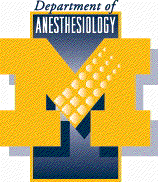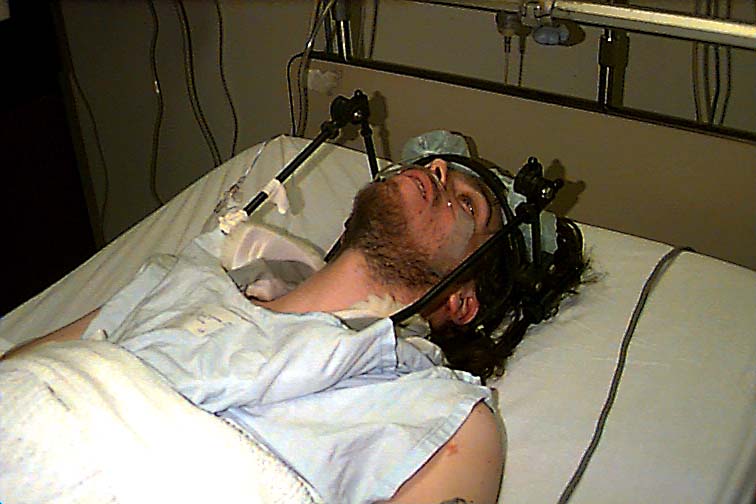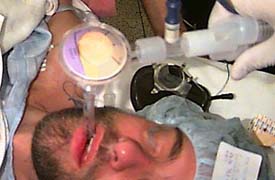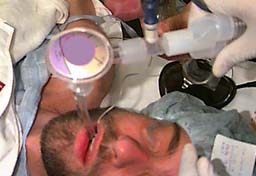 Go to Front Page
Go to Front Page  Go to Scenarios
Go to Scenarios  Go
to Techniques
Go
to Techniques
Confirmation of ETT placement
The fact that the ET has passed through the vocal cords must be confirmed
after intubation. Esophageal intubation may have delayed recognition in
the emergency situation especially in an arrest. Any methods available should
be used to confirm placement and this should be double or triple checked
with whatever options are present.
Methods:
Direct visualization of the tube passing through the cords
Palpation of the tube balloon
Mist in the tube
Chest rise
Breath sounds with no sounds over the stomach
Capnography/Carbon Dioxide detection
For the emergency situation away from the OR capnography is not usually
available. A Nellcor Easy Cap is an easily portable elbow connector which
is able to quatifiably demonstrate the presence of CO2 in expired gas coming
out of the ET. It should carried in the code box by anesthesiologists responding
to arrests and emergency intubations on the wards and ICUs.

The Easy Cap turns yellow during expiration with an ETCO2 greater than approx
25 mmHg.

Th Easy Cap turns purple with each inspiration of fresh gas
The Easy Cap can also be used to indicate the adequacy of CPR as poor perfusion
will result in low ETCO2 levels and an absence of the yellow color as seen
above.
ASA Difficult Airway Algorithm
Difficult intubation is defined as inadequate visualization of the glottis,
and failed intubation as inability to insert a tracheal tube through the
cords into the trachea [reference 15]. Predicting
difficult intubation is not an easy task. The current airwy evalations of
Mallanpati class, thryomental distance and head extension all have significant
false positives and false negative rates. However, when used together the
specificity and sensitivity will increase. Studies have shown that though
they have little value in prediciting difficult intubations, when negative
there is a high probability the intubation will be easy [reference
16].
When the clinician considers how to intubate a patient, a back-up plan should
be considered in case plan A fails. Maintaining oxygenation of the patient
is paramount. The patient should not be allowed to suffer hypoxia while
attempts at intubation are being made and failing. Whether the patient is
able to ventilate spontaneously is key in deciding upon a back up plan.
If the patient is still ventilating spontaneously then there is time for
an alternate plan to be formed.
If the patient is no longer breathing then establishing ventilation of the
patient is paramount. This is the reason some anesthesiologists feel that
all emergency intubations away from the operating rooms should be done with
minimal sedation and topicalization and no muscle relaxants.
Knowledge of the ASA difficult airway algorithm is useful in this situation.
This gives the clinician guidelines in how to handle the situation of the
difficult airway and how to handle the situation of cannot intubate and
cannot ventilate.
Laryngeal Mask Airway (LMA)
 LMA
LMA
 LMA insertion
LMA insertion
The LMA is a useful adjuvant to airway management [reference
17]. It sits in the oropharynx and covers the glottic opening. The LMA
provides an excellent airway for spontaneous respiration and can also be
used for positive pressure ventilation. It is easy to place, and it has
been used in emergency circumstances in the difficult airway after failed
intubation. However, it does not prevent the stomach from becoming insufflated
with air or prevent against aspiration of regurgitated stomach contents.
In spite of this it can be life saving in the management of the emergency
airway. It is possible to intubate through the LMA either using a fiberoptic
bronchoscope or directly passing a bougie or a 6.0 endotracheal tube, gaining
a more definitive airway and guarding against aspiration.
References
1. Anesthesia, Fourth Edition. Miller, RD, Editor.
Churchill-Livingston. 1994. Pages 2163-2165.
2. Hemodynamic and electroencephalogram changes
during Rapid-Sequenctce Induction of Anaesthesia. Kanaya, N., Nakauama,
M, Fujita, s. and Nmiki, A. Can J Anaesth 1994 41:8. pp699-702.
3.Intracranial Presuurin during induction of
anaesthesia and tracheal intubation sith etomidat-induced EEG burst Supprssion.
Modica,PA , Tempelhoff R. Can J Anaesth 1992 (39:3) pp.236-44.
4. Succinylcholine does not change intracranial
pressure, cerebral blood flow velocity or the electroencephelogram in patients
with newurologic injury. Kovarik WD, Mayberg TS, Lam AM, Mathiewsen TL,
Winn HR. Anesth Analg 1994; 78:469-73.
5. Effect of Lidocaine on ICP response to endotracheal
suctioning. Yano, M, MDm Nishiyama, H, MD Yokotoa, H, MD, Kato, K, MD, Yamamoto,
Y, MD and Otsuka, T,MD. Anesthesiology 1986; 64:651-653.
6. Oriohylactic Lidocaine use preintubation:
a review. J Emerg Med (1994 Jul-Aug) 12(4):499-506.
7. Principles and Practices of Anesthesiology:
Rogers MC, Tinker JH, Covino BG, . and Longnecker DE,. Mosby -Year Books,
Inc. Page 1522.
8. An Impaled Neck. Management of difficult airway
access. Bulinham A., Hampson-Evans D, and Palzzo, M. Anaesthesia, 1994,
Vol. 49 pp866-869.
9. Initial Evalustion and management of upper
airway injury in trauma patients. Cicala RS, Kudsk KA, Butts A, Nguyen H
, and Fabian TC, . J Clin Anesth. Vol 3. March/April 1991.
10 Airway management for trauma patients with
potential cervical spine injury. Hasting RH, Marks JD, Anesth Analg, 1991,
73:471-82.
11. Emergency Airway Management in Patiens with
Cervical spine injury. Criswell JC, Parr MJA, . Anaesthesia, 1994, Vol.
49 pp.900-903.
12. The Safety of Emergency Neuromuscular Blockade
and Orotracheal Intubation in the Acutely Injured Trauma Patient. Norwood
S, Myers, and Butler, TJ.
13. Emergency intubation for paralysis of the
uncooperative trauma patient. J Emerg Med (1991 Jan-Apr) 9(1-2):9-12.
14. Difficult intubation in the parturient. Davies
JM, Week S, Crone LA, Pavlin, E, MD. Can J Anaesth 1989 (36:6)pp.688-74.
15. Difficult Tracheal Intubation: A Retrospective
Study. Sampsoon GLT MD, and Young JRG, Anaesthesia, 1987, vol. 42 pp 487-490.
16. New Concept in the Management of the Difficult
Airway. Marks JD, and Bogez S, Clinical Anesthesia Upkates Vol 5, Number
3.
17. The Laryngeal Mask Airway. Its uses in Anesthesiology.
Pennant JH, and White PF. Anesthesiology Vol. 79, No. 1. Jul 1993.
 Go to Front Page
Go to Front Page  Go to Scenarios
Go to Scenarios  Go
to Techniques
Go
to Techniques